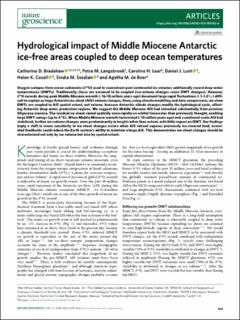| dc.description.abstract | Oxygen isotopes from ocean sediments (δ18O) used to reconstruct past continental ice volumes additionally record deep water temperatures (DWTs). Traditionally, these are assumed to be coupled (ice-volume changes cause DWT changes). However, δ18O records during peak Middle Miocene warmth (~16–15 million years ago) document large rapid fluctuations (~1–1.5‰) difficult to explain as huge Antarctic ice sheet (AIS) volume changes. Here, using climate modelling and data comparisons, we show DWTs are coupled to AIS spatial extent, not volume, because Antarctic albedo changes modify the hydrological cycle, affecting Antarctic deep water production regions. We suggest the Middle Miocene AIS had retreated substantially from previous Oligocene maxima. The residual ice sheet varied spatially more rapidly on orbital timescales than previously thought, enabling large DWT swings (up to 4 °C). When Middle Miocene warmth terminated (~13 million years ago) and a continent-scale AIS had stabilized, further ice-volume changes were predominantly in height rather than extent, with little impact on DWT. Our findings imply a shift in ocean sensitivity to ice-sheet changes occurs when AIS retreat exposes previously ice-covered land; associated feedbacks could reduce the Earth system’s ability to maintain a large AIS. This demonstrates ice-sheet changes should be characterized not only by ice volume but also by spatial extent. | en_US |

